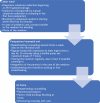Optimizing breastfeeding for hospitalized newborns: A narrative review of midwifery-led interventions
- PMID: 39990624
- PMCID: PMC11843490
- DOI: 10.18332/ejm/200341
Optimizing breastfeeding for hospitalized newborns: A narrative review of midwifery-led interventions
Abstract
Breastmilk is the best source of nutrition for newborns. The World Health Organization recommends exclusive breastfeeding for the first six months of life as it has benefits to mother and child. However, breastfeeding can be challenging. Especially when the newborn is hospitalized, the physical separation of mother and child can make breastfeeding difficult. Hence pre- and post-natal midwife care supporting breastfeeding become more important. The aim of this narrative review is to identify measures taken by midwives in the labor ward, on the postpartum unit and at home that can influence breastfeeding success positively in hospitalized newborns. A literature review was conducted in PubMed and CINAHL and on the website of the European Institute for Breastfeeding and Lactation from April to September 2023. Studies from 2013 to 2023 written in German or English comparing two different measures/groups were considered. Twenty studies were included and five measures, taken by midwives, were identified. Skin-to-skin contact leads to higher (exclusive) breastmilk feeding rates, better sucking behavior and a shorter time to full enteral feeding. Regular breastmilk expression and supervised breastfeeding attempts result in higher breast milk feeding rates. Breastfeeding counselling enables the mothers to access lactation education. Uninterrupted visiting hours lead to higher exclusive breastmilk feeding rates. Midwives play a key role in promoting breastfeeding among hospitalized newborns involving initiating lactation, strengthening the mother-child bond and providing appropriate breastfeeding advice. There is a further need for research, as midwives are rarely involved in studies.
Keywords: breastfeeding success; breastfeeding support; hospitalized newborns; midwife; neonatal ward.
© 2025 Harting K.M. et al.
Conflict of interest statement
The authors have completed and submitted the ICMJE Form for Disclosure of Potential Conflicts of Interest. They declare no competing interests, financial or otherwise, related to the current work. D. Singer reports receiving grants or contracts from Uniscientia Stiftung Vaduz, Liechtenstein. He also reports receiving royalties or licenses from Thieme-Verlag (Journal Editorship) and payments or honoraria from CHIESI and Farmaceutici and AstraZeneca. J. Heiter reports receiving payments or honoraria from Nutricia.
Figures
References
-
- Infant and young child feeding. WHO. December 20, 2023. Accessed January 20, 2025. https://www.who.int/news-room/fact-sheets/detail/infant-and-young-child-...
-
- Lawrence RA, Lawrence RM. Breastfeeding: A Guide for the Medical Profession. Elsevier; 2022. doi:10.1016/C2018-0-02113-1 - DOI
-
- Horta BL, Victora CG. Short-Term Effects of Breastfeeding: A Systematic Review on the Benefits of Breastfeeding on Diarrhoea and Pneumonia Mortality. WHO; 2013. Accessed January 20, 2025. https://iris.who.int/bitstream/handle/10665/95585/9789241506120_eng.pdf?...
Publication types
LinkOut - more resources
Full Text Sources
Miscellaneous

